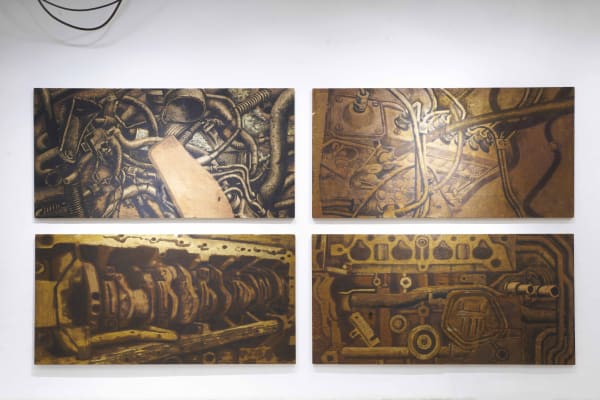Jonathan Okoronkwo - Some Things Stay Broken: Gallery II, Accra
Gallery 1957 is pleased to present Some things stay broken, a solo exhibition by Jonathan Okoronkwo, curated by Tracy Naa Koshie Thompson. The exhibition is on show from December 14th - January 17th.
Objects are explained entirely by the human attempt to achieve human ends, and not by the unavoidable need to adapt ourselves to the objects around us, whose very existence, as such, requires we enter into relationships with them largely on their terms and not ours.
-Ron Richardson, 2020. The Agency of Objects.
Humans usually perceive objects in terms of what they use them for, other than how objects also use and transform humans, and transform the world beyond human relations. Okoronkwo’s interest with machines is not that of the functional machine with coherent parts working harmoniously to achieve a fixed end. The dysfunctional car bodies he paints are not just dead because they are not useful to humans; but they are vibrant things that keep transforming themselves and everything else alongside.
The artist’s muse, Suame Magazine, is one of the biggest industrial clusters in Africa. It is located in Kumasi, roughly covering 576 square metres. This is where Okoronkwo takes his dystopian imagery and inspirations from. Suame Magazine is a site of colossal assemblage of disposed spare parts from vehicles all over the world. One cannot escape the invasive smells of ‘dirty oils’ in the air with metal and plastic debris that makes strangers uncomfortable. Although chaotic, this site creates room for new possibilities and resolving what constitutes the meaning of ‘chaotic’. By creating profound forms and processes, beyond the canons of Western standardised automotive assembling. The colossal scale and cluster of different car body parts in such a site, transforms automotive artisanry itself. Suame Magazine, which is itself a dynamic machine, transforms and challenges its artisans to invent new possibilities that do not issue from or conform to the pre-set structural coherence of the imported vehicles themselves.
- Extract from Curatorial essay by Tracy Naa Koshie Thompson








